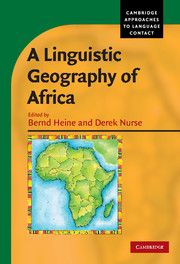Book contents
- Frontmatter
- Contents
- List of maps
- List of figures
- List of tables
- List of contributors
- Series editor's foreword
- Acknowledgments
- Abbreviations
- 1 Introduction
- 2 Is Africa a linguistic area?
- 3 Africa as a phonological area
- 4 Africa as a morphosyntactic area
- 5 The Macro-Sudan belt: towards identifying a linguistic area in northern sub-Saharan Africa
- 6 The Tanzanian Rift Valley area
- 7 Ethiopia
- 8 The marked-nominative languages of eastern Africa
- 9 Africa's verb-final languages
- Notes
- References
- Index
6 - The Tanzanian Rift Valley area
Published online by Cambridge University Press: 22 September 2009
- Frontmatter
- Contents
- List of maps
- List of figures
- List of tables
- List of contributors
- Series editor's foreword
- Acknowledgments
- Abbreviations
- 1 Introduction
- 2 Is Africa a linguistic area?
- 3 Africa as a phonological area
- 4 Africa as a morphosyntactic area
- 5 The Macro-Sudan belt: towards identifying a linguistic area in northern sub-Saharan Africa
- 6 The Tanzanian Rift Valley area
- 7 Ethiopia
- 8 The marked-nominative languages of eastern Africa
- 9 Africa's verb-final languages
- Notes
- References
- Index
Summary
Introduction
The Rift Valley area of central and northern Tanzania is of considerable interest for the study of language contact, since it is unique in being the only area in Africa where members of all four language families are, and have been, in contact for a long time, having had linguistic interaction of various intensity at various points in time, which is reflected by convergence in parts of their grammatical structures (see map 6.1). The modern languages that took part in this linguistic contact are the West Rift languages of Southern Cushitic (Iraqw, Gorwaa, Alagwa, and Burunge), the Datooga dialects of Southern Nilotic, some Bantu languages of the F zone (Nyaturu, Rangi, Mbugwe, and maybe Nilyamba, Isanzu, and Kimbu), and Sandawe and Hadza, the Khoisan languages of eastern Africa. Actually, in the absence of any unambiguous indication that Hadza is genetically linked to Khoisan, it is better to be considered a linguistic isolate; see Sands (1998). The fact that the languages involved come from different, genetically unrelated families makes this area very promising for the study of language contact in that similarities between languages have five possible explanations: (i) universal properties, (ii) chance, (iii) borrowing or diffusion, (iv) retention, or (v) parallel development (Aikhenvald & Dixon 2001).
- Type
- Chapter
- Information
- A Linguistic Geography of Africa , pp. 186 - 227Publisher: Cambridge University PressPrint publication year: 2007
- 31
- Cited by

